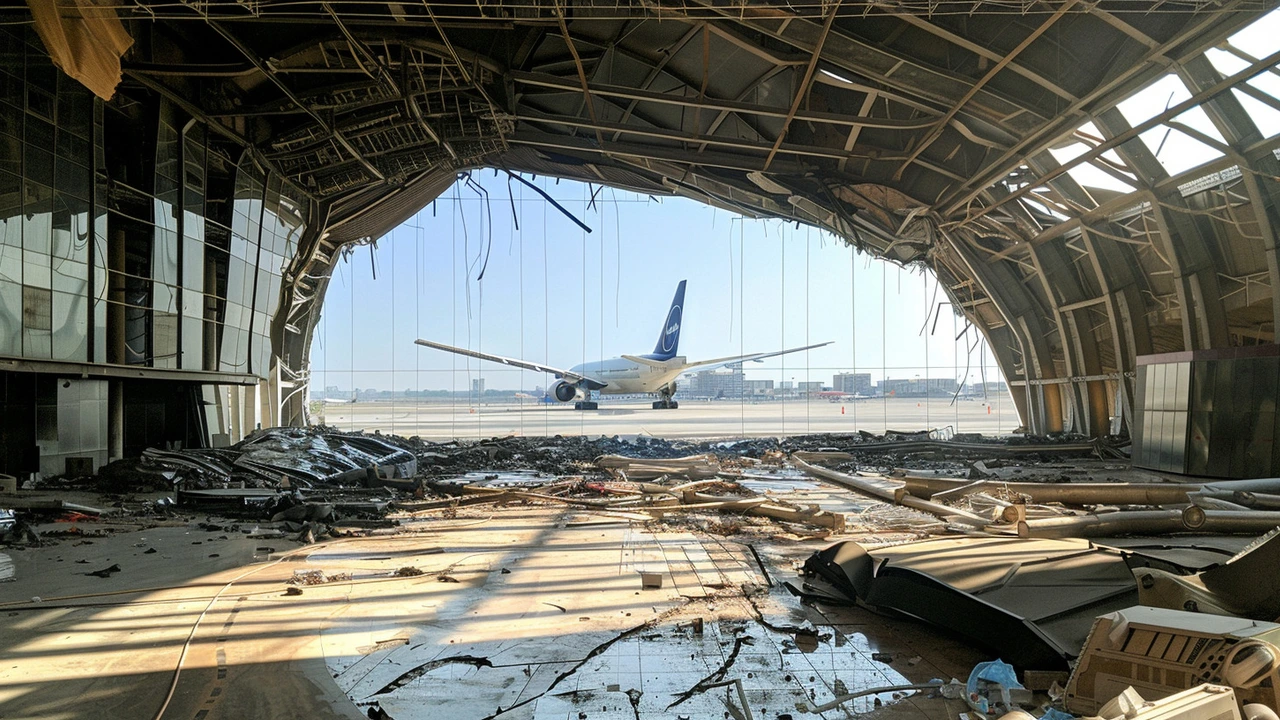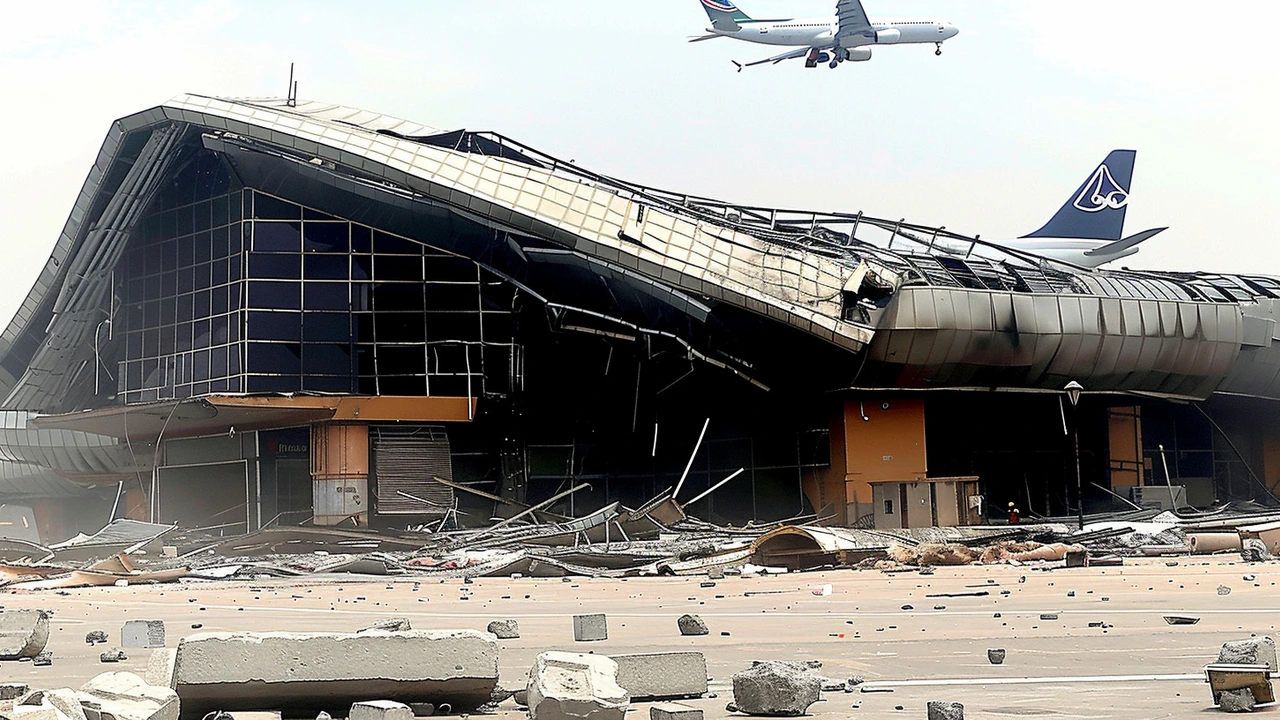Tragic Roof Collapse at Delhi Airport
An unfortunate event early Friday morning has cast a spotlight on the structural integrity of airport facilities across India. The roof at Terminal 1 of Indira Gandhi International Airport (IGIA) in Delhi gave way during a bout of heavy rain, leading to a fatality and injuring several others. The incident disrupted operations significantly, resulting in the cancellation of over 100 flights. Passengers scheduled to depart from this terminal, which primarily services flights by IndiGo and SpiceJet, faced major inconveniences as flights were redirected to other terminals within the airport complex.
The calamity has elicited a swift response from the Indian government, aimed at ensuring no such incident occurs again. A top-level review meeting was convened by Civil Aviation Minister K Rammohan Naidu, leading to the decision to conduct comprehensive inspections of all airports across the country. A 24×7 operational war room has been set up at Terminals 2 and 3 of IGIA to coordinate passenger services seamlessly and mitigate further disruptions.
Implications for Nationwide Airport Safety
The Ministry of Civil Aviation has been vocal on the need for these inspections, stipulating that they should be completed within 2-5 days. The Airports Authority of India (AAI) has issued immediate directives for all airports—both major and minor—to undergo thorough inspections. These evaluations will look into current safety measures and help develop long-term policies for more robust structural maintenance. The goal is to ensure the safety and comfort of passengers while safeguarding the efficiency of airport operations.
Structural engineers from the prestigious Indian Institute of Technology (IIT) Delhi have been specifically tasked with evaluating the damage at Terminal 1's old departure forecourt. Their insights will be pivotal in understanding the causes and extent of the collapse, laying the groundwork for not just repairing the damage, but also averting similar incidents in the future.

Immediate and Long-Term Investigations
In parallel to the government’s efforts, two other entities are diving deep into the root causes of this incident. The Directorate General of Civil Aviation (DGCA) and a technical committee established by Delhi International Airport Limited (DIAL) are both conducting independent investigations. These probes aim not just to identify the causes but also to attribute accountability, ensuring that lapses, if any, are rectified and those responsible are held to account. It's crucial that such a tragic event does not repeat, and these detailed investigations are steps in the right direction.
The government's immediate actions underscore the critical need for robust structural maintenance and stringent regulatory oversight within India's aviation industry. While Terminal 1 remains a focus due to the extent of the damage and its immediate impact on passengers, the broader initiative to review all airport structures aims to fortify the country's aviation infrastructure on a national scale.
Impact on Passengers and Airlines
The collapse has had a ripple effect, disrupting travel plans for thousands of passengers. In the wake of the incident, airlines have been directed by the aviation ministry to maintain normal airfare rates for Delhi-bound flights. This measure aims to prevent exploitation of the situation by keeping air travel affordable despite the disruptions. The chaos at Terminal 1 has necessitated the redirection of affected flights to Terminals 2 and 3, which has required significant logistical coordination to manage the sudden influx of additional passengers and flights.
For airlines like IndiGo and SpiceJet, this has meant rapid adjustments to operations, schedules, and passenger services. The robust response from the government and airport authorities has been critical in managing the crisis, but it has undoubtedly put a strain on resources and operational capabilities. The establishment of the war room at Terminals 2 and 3 is a significant step in ensuring that passenger services are managed efficiently during this challenging period.

Looking Ahead
In the aftermath of this tragic event, the Indian government’s proactive stance aims to not just address the immediate fallout but also to pave the way for improved safety regulations. The comprehensive inspection of all airports is a clear sign that passenger safety and operational integrity are non-negotiable. The insights gained from these inspections will be crucial in shaping policies and practices that ensure no such incident occurs again. It is a somber reminder of the importance of regular and rigorous safety checks in maintaining the trust and confidence of the traveling public.
While the investigations and inspections are underway, the incident at Terminal 1 of IGIA stands as a poignant reminder of the need for continuous vigilance and maintenance of critical infrastructure. Ensuring the safety of passengers and the smooth operation of airport facilities remains paramount. The forthcoming weeks will likely see a surge of activity across India's airports as authorities work swiftly to complete the mandated inspections and implement necessary safety enhancements.
For passengers, the immediate focus is on navigating the disruptions with as little inconvenience as possible. For the broader aviation industry, this is a time of introspection and action, ensuring that the lessons learned from this tragic event lead to stronger, safer airport operations across the country.


Comments
christine mae cotejo
When news of the Delhi Airport roof collapse broke, my mind immediately raced to the cascading effects such a structural failure can impose on a nation's aviation ecosystem. The rain‑laden monsoon that battered Terminal 1 was a stark reminder that nature can expose the frailties hidden within aging infrastructure, and that vigilance must be relentless. Engineers from IIT Delhi diving into forensic analysis is a commendable step; their expertise will illuminate the exact stress points and material fatigue that culminated in this tragedy. Yet the lessons extend far beyond a single terminal-every airport corridor, hangar roof, and passenger lounge across the subcontinent must now be scrutinized under a microscope.
First, a comprehensive audit of load‑bearing elements, especially in older constructions, should be mandated, employing non‑destructive testing methods such as ultrasonic pulse velocity and ground‑penetrating radar. Second, the implementation of a digital twin for each airport could enable real‑time monitoring of structural health, flagging anomalies before they manifest visibly. Third, a standardized schedule for preventive maintenance, aligned with international ICAO recommendations, would institutionalize safety rather than leaving it to ad‑hoc inspections.
Furthermore, the coordination hub-or war room-established at Terminals 2 and 3 sets a precedent for crisis management, but its efficacy hinges on transparent communication channels with airlines, ground staff, and passengers. A public dashboard updating flight statuses, inspection progress, and safety certifications would soothe public anxiety and restore confidence.
From a policy perspective, the Ministry’s directive to complete nationwide inspections within a 2‑5‑day window is ambitious; however, ensuring depth over speed is paramount. Investing in training programs for airport maintenance crews on modern inspection technologies will pay dividends beyond the immediate emergency.
In the longer term, integrating resilient design principles-such as roof systems engineered to shed water efficiently and accommodate thermal expansion-into all future airport projects will mitigate similar risks. The tragedy, while heartbreaking, offers a pivotal opportunity for India’s aviation sector to leapfrog into a new era of safety, transparency, and technological integration.
June 29, 2024 at 18:28
Douglas Gnesda
From an operational risk assessment standpoint, the roof collapse underscores a glaring gap in our lifecycle asset management protocols. The incident triggers a cascade of compliance checkpoints: structural integrity verification, load distribution recalibration, and micro‑climate impact studies-all of which must be quantified using probabilistic risk assessment models. Deploying structural health monitoring (SHM) sensors across critical joints can generate real‑time data streams, feeding into predictive analytics powered by machine learning algorithms. In plain terms, we need to shift from reactive repairs to proactive, data‑driven maintenance-think of it as predictive policing for infrastructure.
June 29, 2024 at 18:30
Abhijit Pimpale
The report correctly identifies the need for thorough inspections, but it omits the statutory requirement under the Airports Act, Section 12(b), which mandates quarterly structural audits for all public terminals. Additionally, the term "fatality" should be used in the singular form as only one life was lost. These details are crucial for legal compliance and accurate public communication.
June 29, 2024 at 18:31
Eric DE FONDAUMIERE
Yo, this is a perfect chance to rally the crews! Let’s get those SHM sensors up fast-no more waiting till the next monsoon. Even if we typo a bit, the goal stays: fix the roofs, keep the flights rolling. Let's push the admin to allocate budget now, cause waiting is just dangerous!
June 29, 2024 at 18:33
Pauline Herrin
While the government's swift establishment of a war‑room is commendable, the communication strategy appears fragmented. A more structured, hierarchical dissemination of updates, adhering to formal briefings, would alleviate passenger uncertainty and uphold the Ministry's reputation for procedural rigor.
June 29, 2024 at 18:35
pradeep kumar
The response is a half‑hearted PR stunt.
June 29, 2024 at 18:36